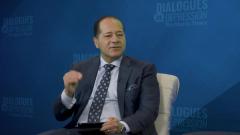
Glutamate's Rapid Impact: A New Approach to MDD Management
Clinicians discuss past treatment options compared to novel glutamate-modulating agents, highlighting their rapid onset of symptom relief.
Episodes in this series

Transcript
Gus Alva, MD, DFAPA: As [recently as] a few years back, glutamate wasn’t even considered one of the neurotransmitters that we should actually be thinking about. It was just considered an amino acid. But now we talk more about excitatory, inhibitory issues beyond the monoaminergic story that we’ve obviously been utilizing in major depressive disorder for a while. Any other thoughts regarding this? I completely concur, Greg, [with] your point [that] the sprouting of really healthy dendritic growth and so on is really critically driven by glutamate. But we’re also finding new ways, new interventions to help out with major depressive disorder that are more steered toward this particular neurotransmitter.
Craig Chepke, MD, DFAPA: I think they couldn’t come soon enough. I mean, we’ve all got patients with MDD [major depressive order] who have struggled and have not been able to find either efficacious treatments or tolerable treatments, and having a new MOA [mechanism of action] can maybe open some doors for those people. And especially as you said, Greg, with the predominance of the synapses in the cortex being glutamatergic, tapping into that versus the small percentage that are monoaminergic to me makes a ton of sense.
Greg Mattingly, MD: I’ll even go back in time. So, once again, going back to my pivotal moments of my career, in 1986, the Nobel Prize [was awarded] for the discovery of neural growth factors that were modulated by glutamate. We’ve known about this for a long time, but we haven’t had good tools that modulated it. I think we’ve been stuck in the monoamine generation because that’s what our tools modulated. We talked about raising monoamines, stimulating monoamines. That’s where we were because we had tools, but now we’ve developed a whole new group of tools that can modulate that glutamate-GABA [γ-aminobutyric acid]-neuroplasticity junction.
Gus Alva, MD, DFAPA: That’s amazing because out of about 100 billion neurons, right, 2000 to 300,000 would be serotonergic in nature, and that’s specifically what they’re addressing right now. So maybe it’s a leap forward in time right now. That’s really interesting. What I’d like to do is take a look at another interesting point, and that is that in the context of depression, glutamate obviously garnered a lot more attention, and we basically note that when you take a look at manipulating this particular pathway, there might be some nice entry points of getting individuals better maybe sooner? That would be another very important thing to consider?
Greg Mattingly, MD: Let’s go back to science once again. Science tends to spur innovation. And what basic science tells us is that when you manipulate the GABA-glutamate junction, when you turn on receptors for NMDA [N-methyl-D-aspartate] and AMPA [α-amino-3-hydroxy-5-methyl-4-isoxazole propionic acid], it doesn’t take weeks to months to have an effect. You see changes within hours. Within hours, you can see nerve cells starting to grow and cross-connect to establish neuroplasticity to restore neural function. So this whole new generation of what we now think of as the fast-acting group of medicines, basic science says within hours to several days, they should start working. Then, Gus, I know you, and I have been involved in trials where we say, “OK, let’s [not] bring somebody back in a week or two. Let’s bring you back tomorrow and see if there’s been a difference.”
Erin Crown, MHS, PA-C: We’ve always treated major depressive disorder with this monoamine approach, looking at serotonin, norepinephrine, and dopamine as modalities to treat. But the problem with that in part has been that that’s all downstream effect, right? And that’s why we don’t typically see improvements for that 3- to 8-week time frame. And so to Greg’s point, when we are looking at NMDA and modulation of glutamate, we get activity right away.
Gus Alva, MD, DFAPA: And coming back to your point, Erin, stress creates changes. We’ve known for quite a long time that you can see changes in the blood, in the cerebral spinal fluid, and imaging studies that correlate with glutamate, so clearly [it’s] a nice target to look at. Greg, your thoughts regarding this issue?
Craig Chepke, MD, DFAPA: Well, I think…one of the biggest that needs in major depressive disorder is the speed of onset. Because the one thing that every person with depression has is a lack of hope. When we tell them that “The best-case scenario is you’re not going to feel anything for about a month. Because if you feel something those first few weeks, chances are it’s probably going to be [adverse] effects. To get any benefit, it’s probably going to be 4 weeks, 6 weeks, maybe longer,” who wants to stick around for that? That’s a bad position to put people in who have major depressive disorder. I love the promise of these new rapid-acting agents that it could maybe change that for a lot of people. And I’d modify slightly your analogy of the gas pedal, Greg. I would say the gas pedal doesn’t actually make the car go, the engine makes the car go. And so, I would say glutamate is more like the engine of the car, the monoamines are like the gas pedal. You push on the gas pedal, but it just tells the engine to go; that’s the big V-12 beast that glutamate can be for some patients. We tell [glutamate] to go directly instead of going through that intermediary of the monoamines. That’s exciting to me.
Gus Alva, MD, DFAPA: That’s an excellent point, because obviously monoamines are important also, right? We see that there’s a cohesive process along the lines of tying it all together.
Erin Crown, MHS, PA-C: Modulating glutamate tells it to go fast, right? When we think about the symptoms of major depressive disorder and the impact that they have on the lives of the individuals that experience them, evolution and anergia resulting in lack of self-care and maybe not getting to work, not caring for dependence, whether they’re older adults or child dependence, financial implications and things of that nature, we really need things that can help us reinforce that urgency to treatment, to helping someone getting onto that path to recovery more quickly and getting back to life.
Transcript was AI-generated and edited for clairty.
Newsletter
Receive trusted psychiatric news, expert analysis, and clinical insights — subscribe today to support your practice and your patients.

































